Key takeaways:
- Indoor plant pests can cause significant damage, highlighting the importance of early identification and regular inspections.
- Natural pest control methods, like neem oil and beneficial insects, can be effective without harming the environment.
- Maintaining a consistent watering schedule and ensuring proper air circulation are crucial for long-term pest prevention.
- A hands-on pest management approach, combined with proactive care, enhances the health and resilience of indoor plants.

Understanding indoor plant pests
Indoor plant pests can be tricky little foes that sneak up on your green companions. I remember the first time I discovered a couple of aphids on my beloved hibiscus. It was a gut-wrenching moment, feeling helpless watching them feast on my plant. These tiny insects not only damage leaves but can also spread diseases that can affect the whole plant.
Every plant can potentially attract different pests, depending on its environment and condition. Have you ever noticed how a stressed plant is more likely to fall victim to infestations? I’ve certainly found that out the hard way. Providing proper care can create a healthier plant less susceptible to these pests.
Understanding which pests are common can help you react quickly. For instance, I’ve seen spider mites multiply rapidly, turning vibrant green leaves into a desolate sight within days. Recognizing the signs early, like webbing or speckled leaves, can mean the difference between saving your plant or losing it altogether. It’s a constant learning experience and one that keeps me on my toes as an indoor gardener.
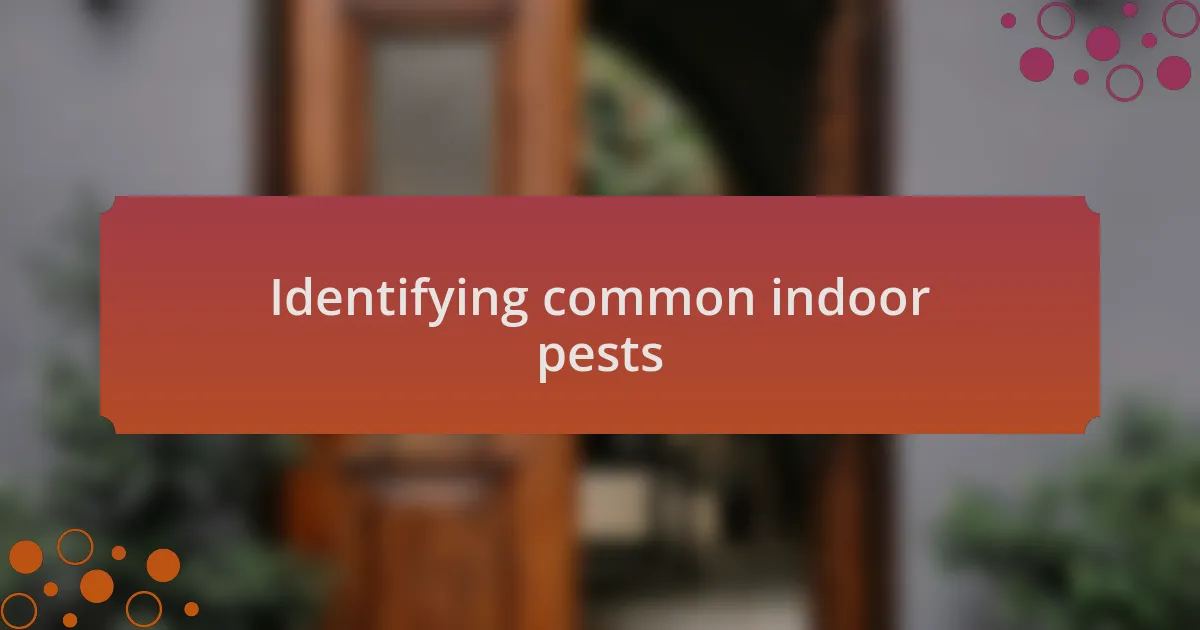
Identifying common indoor pests
Identifying common indoor pests is essential for maintaining a healthy indoor garden. One pest I frequently encounter is the mealybug, characterized by its white, cotton-like substance. The first time I saw them on my jade plant, I was surprised at how deceptive their appearance could be—they looked so harmless, yet they caused significant damage once they settled in.
Another common culprit is the fungus gnat, often found hovering around the soil of overwatered plants. I’ve had my fair share of these pesky flyers. Their larvae that live in the soil actually feed on roots, which can stunt a plant’s growth. Have you ever noticed tiny black flies buzzing around? That’s them, and it’s vital to act fast before they become a bigger problem.
Then there are scale insects, which I found on my rubber tree once. They cling tightly to stems and leaves, often going unnoticed until it’s too late. It’s a reminder of how important it is for me to regularly inspect my plants. Simple checks can save me from battling serious infestations later, reinforcing my belief that being proactive is crucial in indoor plant care.
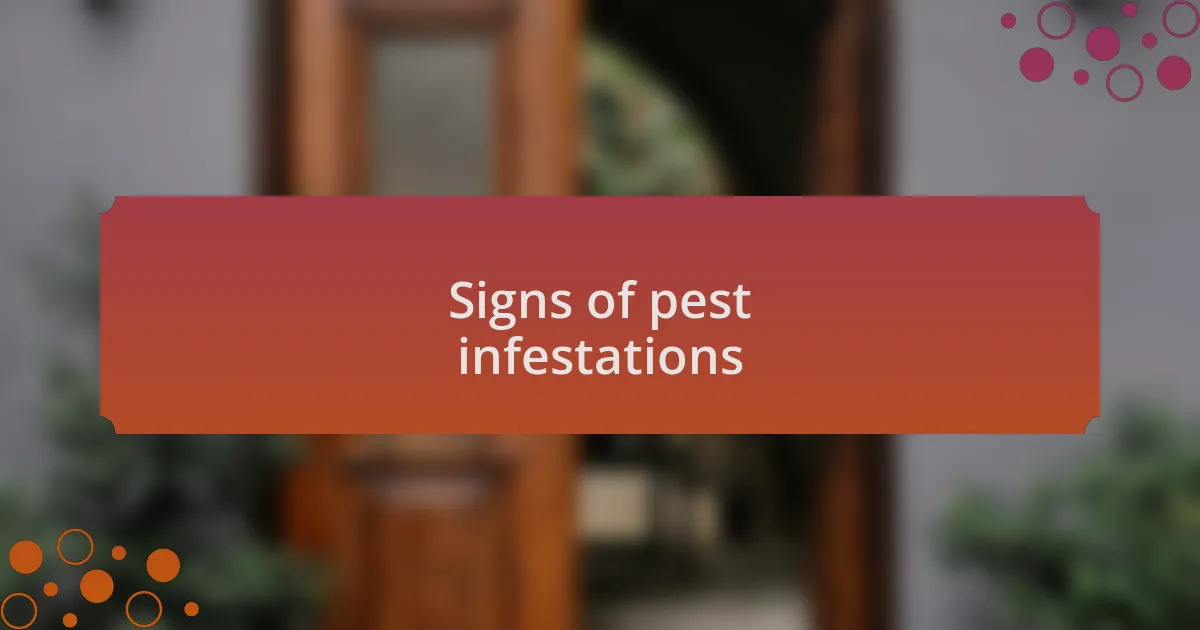
Signs of pest infestations
When it comes to spotting signs of pest infestations, the first red flag I often notice is yellowing leaves. I remember when my beloved fiddle leaf fig started to lose its vibrant green color; I initially dismissed it as a lack of light. But then, I discovered tiny webs beneath the leaves, a telltale sign of spider mites. Have you ever experienced that moment of realization? It’s gut-wrenching to think pests could be the culprit behind a plant’s distress.
Another concerning sign is sticky residue on the leaves or surrounding surfaces. Not too long ago, I found this mysterious goo on my coffee plant, which led me to suspect aphids were at play. The sticky substance, known as honeydew, is produced by these pests as they feed on the plant’s sap. If you’ve seen shiny spots on your leaves, don’t ignore them; they’re often accompanied by other signs of infestation.
Lastly, keep an eye out for any unusual black spots or mold growth. I once noticed a faint powdery mildew on my succulents after treating them for a previous infestation. It turned out to be a side effect of the stress caused by the pests, and that realization made me even more vigilant about my care routine. Have you ever had to deal with this? It deepens my commitment to understanding these signs and acting swiftly to protect my plants.
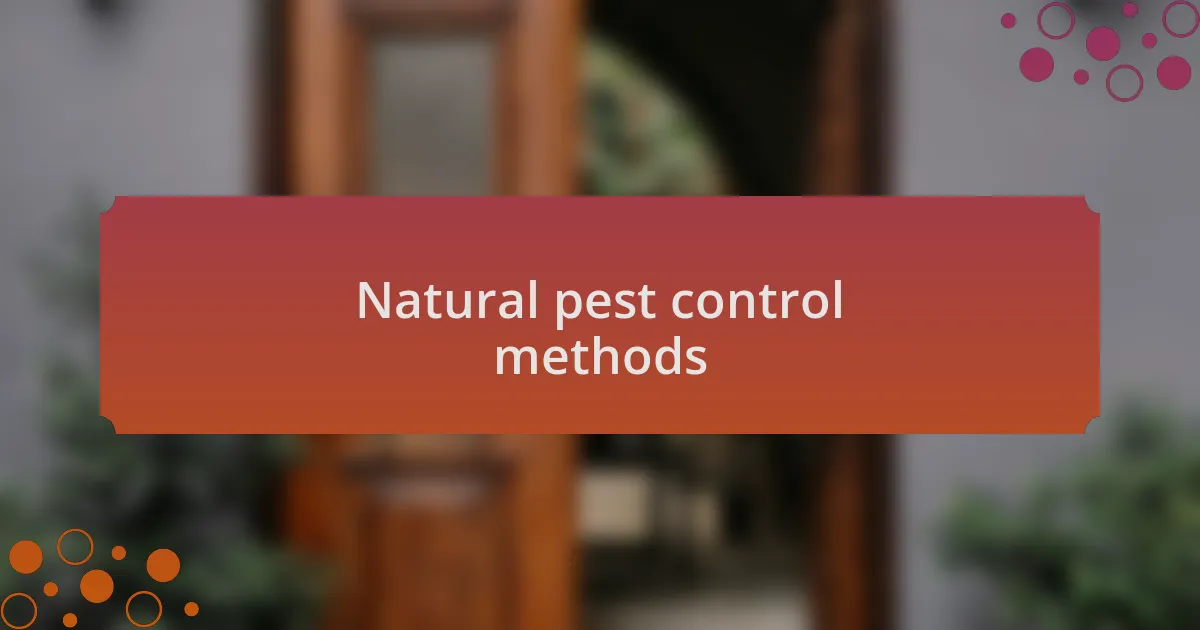
Natural pest control methods
One effective natural pest control method I’ve embraced is the use of neem oil, derived from the seeds of the neem tree. A while back, I discovered that applying diluted neem oil not only eradicated a minor aphid problem but also acted as a preventive measure for future infestations. Have you ever experienced the relief of seeing your plants thrive again after a successful treatment? It’s truly rewarding to know that I’m using something natural that won’t harm beneficial insects.
Another strategy I’ve found quite effective is introducing beneficial insects into my indoor garden. For instance, I once released ladybugs and found them highly efficient at tackling a troublesome aphid issue. Watching them patrol my plants, consuming pests without damaging the foliage, felt like having little guardians in my home. How satisfying is it to know that nature has its own defenders?
I also swear by homemade insecticidal soap, which is simple to mix and can be a game changer. A few years ago, I was battling a mealybug attack on a cherished succulent. After whipping up a solution with liquid soap and water, I sprayed it diligently for a few days, and it worked wonders. Have you ever tried creating your own solutions? It not only saves money but also gives a sense of accomplishment when your plants start showing signs of recovery.
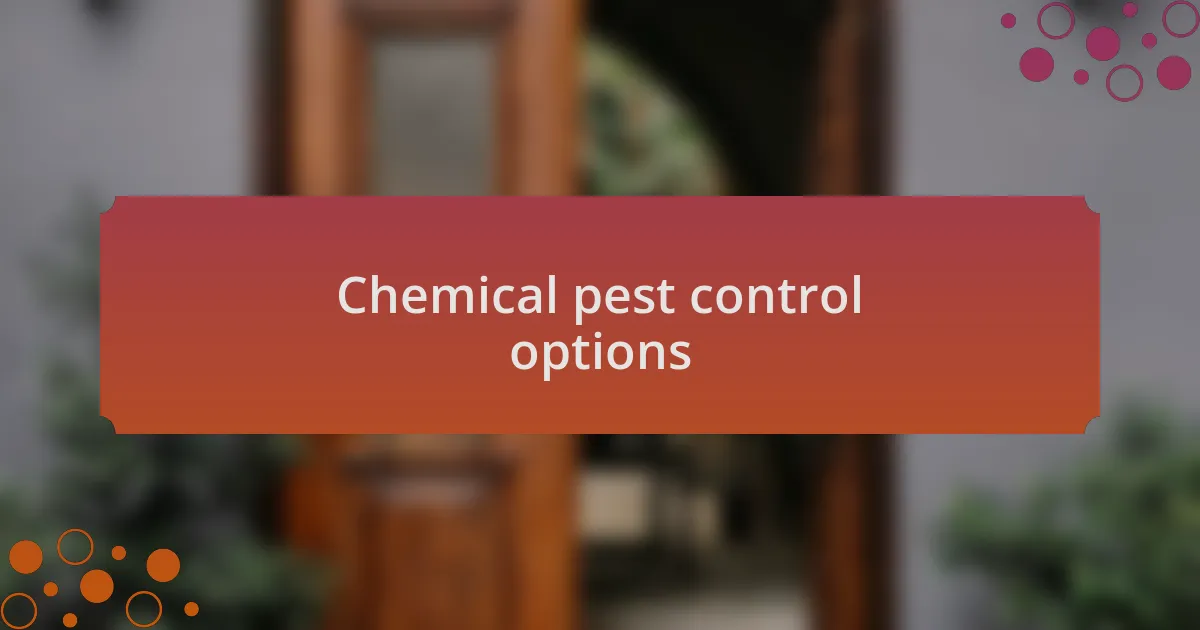
Chemical pest control options
Chemical pest control options can indeed be a lifeline for indoor gardeners. I remember the first time I decided to use a chemical insecticide after a severe infestation of spider mites. Applying it felt a bit nerve-wracking because I was worried about the strong chemicals potentially harming my plants or the environment. However, I must say the results were immediate and effective, which left me wondering if I’d been too cautious for too long.
When considering chemical options, systemic insecticides are worth mentioning. These products are absorbed by the plant, targeting pests when they feed on the foliage. I once tried a systemic treatment during a pest outbreak and was surprised to see lingering effects that kept pests at bay for weeks. Have you ever thought about how some solutions not only help in the short term but also provide long-lasting protection?
I also discovered the importance of following safety guidelines when using chemical controls. After experiencing a mild respiratory reaction from overexposure during one of my applications, I learned to approach chemical treatments with more care. It’s crucial to protect not just your plants but also yourself—do you take necessary precautions when applying chemicals to your indoor garden? Remembering to wear gloves and a mask transformed my experience, making it not only safer but also more effective.
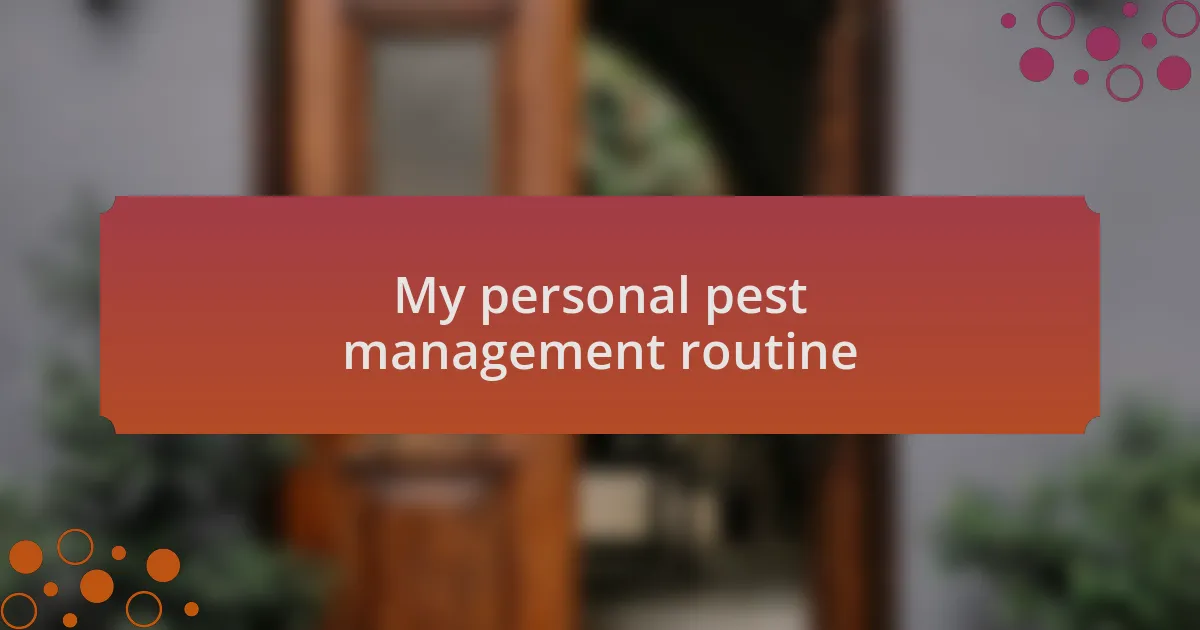
My personal pest management routine
When it comes to my pest management routine, I always start with a thorough inspection of my plants. It’s something I’ve come to appreciate over time; walking through my indoor garden, I often find myself looking closely for any signs of trouble. Have you ever experienced the unease that comes with discovering a pest lurking in your own beloved plants?
After spotting any potential pests, I usually opt for a mixture of neem oil and water as my first line of defense. I remember the day I first tried this solution—applying it felt more like nurturing my plants than fighting off invaders. The feeling of knowing I was using something natural made me confident, and seeing the pests gradually diminish was incredibly satisfying. It’s a reminder of how effective simple solutions can be when combined with regular monitoring.
On some occasions, I find that a more hands-on approach is needed. There was a time when aphids invaded a few of my favorite plants, and I resorted to manually wiping them off with a damp cloth. While it was tedious, the sense of accomplishment that came from that direct action was gratifying. Have you ever felt a rush of pride from a small victory in your indoor gardening journey? Each time I notice a plant thriving post-pest battle, it reinforces my commitment to take an active role in their care.
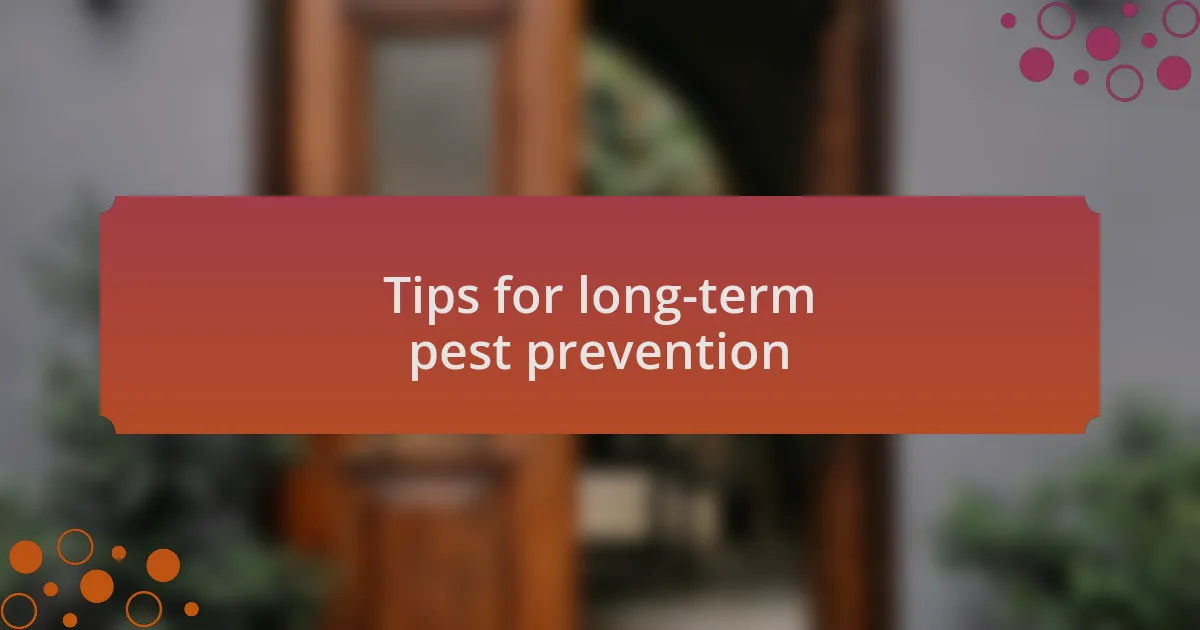
Tips for long-term pest prevention
To truly prevent indoor plant pests over the long term, I’ve found that maintaining a consistent watering and fertilizing schedule is crucial. When I first opened my indoor garden, I didn’t realize how crucial proper hydration was, and I ended up with a few plants that were weak and more susceptible to infestations. It’s amazing how a little routine can vastly improve plant health and resilience, don’t you think?
Another tip that has worked wonders for me is ensuring proper air circulation around my plants. I once crammed several pots close together, thinking that it would create a lush, green oasis. However, I quickly learned that this created a humid environment that pests thrived in. It’s now second nature for me to space them out, allowing air to flow freely and keeping those unwanted guests at bay. Have you experienced a similar realization in your gardening journey?
Lastly, I always make sure to integrate companion planting within my indoor space. I distinctly remember adding marigolds next to my other plants and being pleasantly surprised by their natural repellent properties. It not only helped deter pests but also added a lovely burst of color to my garden. Have you ever noticed how thriving plant communities can support one another? It’s a reminder that nature has its own way of creating balance.